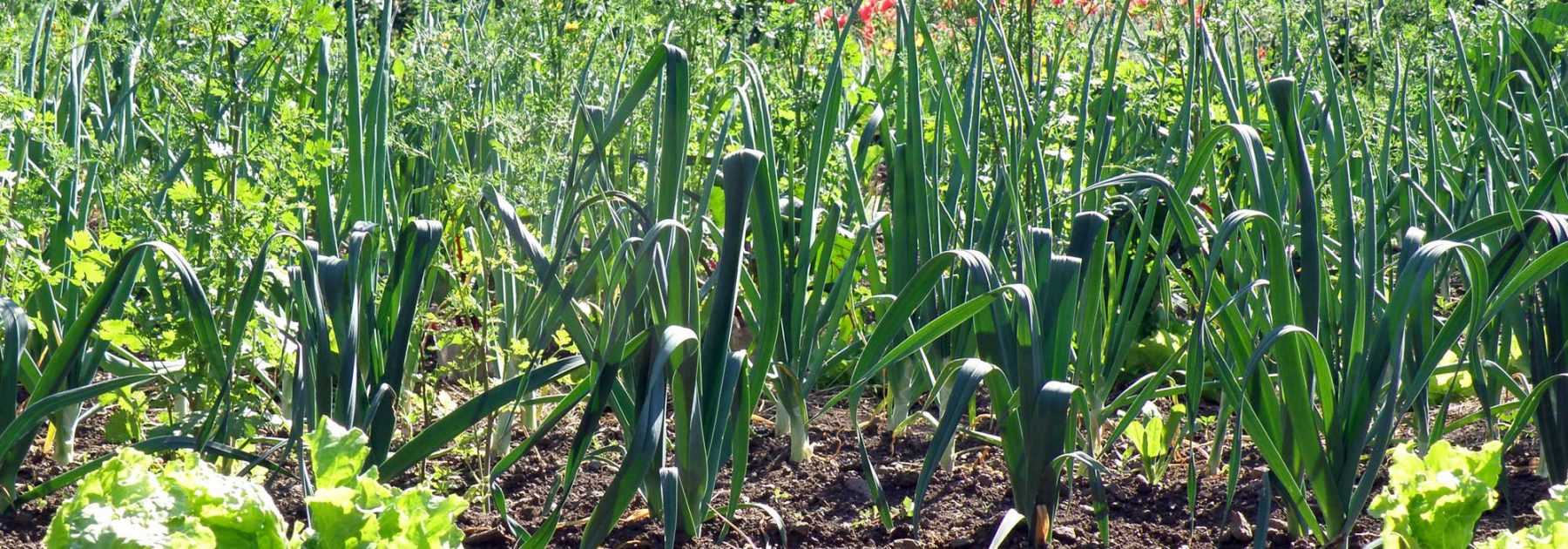
Leeks: sowing, planting, growing, harvesting
Contents
The leek in a few words
- The leek is a leaf vegetable from the Liliaceae family, and can be eaten in its entirety: both the white neck and the green leaves.
- By choosing the right varieties, leeks can be harvested almost all year round.
- They are sown in a nursery from mid-February to mid-May and transplanted two to three months later into their final position in the garden.
- Leeks are easy to grow but require careful attention when planting – they need trimming, root dipping, and well-prepared furrows before planting.
- The leek moth and leek fly are the two main pests affecting leeks, but they’re simple to protect against.
- 5 to 8 months is the typical time needed between sowing and a well-deserved harvest!
Our expert's word
The leek is a leaf-vegetable from the Liliaceae family which includes many vegetable and aromatic plants such as garlic, shallots, onions, and chives. The leek is mainly cultivated for its bole, the white part of the leek, but it can be consumed in its entirety, from the green of the leaves to the roots!
The leek is primarily considered a winter vegetable, which is partly true thanks to the hardiness of certain varieties that can withstand temperatures as low as -15 to -20°C! However, there are a number of summer and autumn leeks. By carefully selecting the varieties it can be harvested during almost all seasons!
Among the fast-growing varieties, i.e., summer leeks, we can mention the ‘Jaune gros du Poitou’ with its light green foliage and excellent taste, the ‘Electra’ leek, producing well-sized boles with bluish, tender leaves for consumption. Among the autumn varieties, which can also be harvested in winter in mild-winter regions, we find the ‘Monstrueux de Carentan’ with its voluminous bole measuring up to 8 cm in diameter; and finally, among the winter leeks, with a more pronounced flavour, the ‘Bleu de Solaize’, an old, very hardy variety, which takes on a violet hue in winter. Note the PGI (Protected Geographical Indication) for the Créances leek in Normandy: it grows in sandy soil enriched by coastal seaweed and receives moisture from sea spray, giving it tenderness and a slightly sweet taste, a must-try!
Growing leeks requires a sunny spot and light, well-loosened and draining soil, rich but without fresh manure, ideally composed of compost spread a few months in advance. Maintenance during cultivation involves regular weeding and hoeing, and monitoring for two fairly common pests, the leek moth and the leek miner.
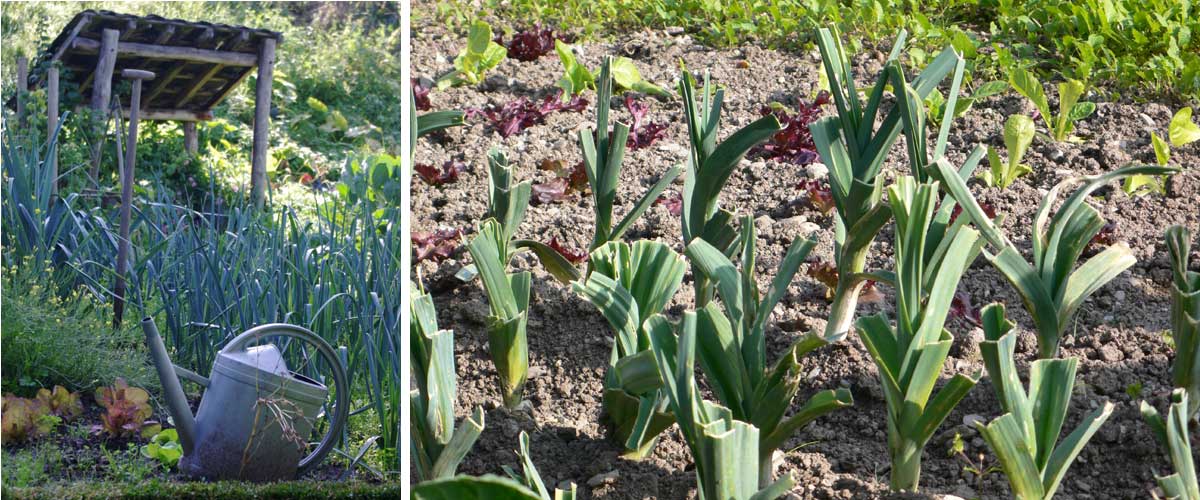
Description and botany
Botanical data
- Latin name Allium porrum
- Family Amaryllidaceae or Liliaceae
- Common name Leek
- Flowering Biennial
- Height 2 years
- Exposure Sun
- Soil type Loose, light, quick-draining
- Hardiness Hardy to very hardy
The leek, or to be precise, leeks, descend from various wild bulbous plants whose geographical range extends across a large Mediterranean area, from Iran to Portugal. Today, we identify 3 forms of cultivated leek: the Taree Irani originating from Iran, the Kurrat, from Egypt and the European leek, originating from southern Europe. Botanists still question today whether these three cultivar groups share a common ancestor. Be that as it may, domestication dates back to 2000 BC in Egypt with the “Kurrat” leek, its foliage was then long and very fine. It was widely consumed by the Romans. We also know that in the Middle Ages, the leek was domesticated throughout Europe. From the 16th century onwards, in France, a distinction was made between long-boled leeks, selected for more productive and summer harvests, and short-boled leeks, resistant to winter.
Etymologically, the name “leek” comes from the Latin porrum, it was formerly called “porreau” and even earlier “por”. The genus name “Allium” comes from the Latin “olere” and means to smell.
The leek or Allium porrum is a biennial herbaceous plant belonging to the Liliaceae family according to the Cronquist classification or the Amaryllidaceae family according to the APG III classification. The leek has long leaves ranging in colour from light to dark green to blue or even mauve depending on the variety and the effect of cold, which tends to accentuate the mauve colour. These leaves, more or less wide, are sheathing and together form what is called a pseudo-stem known as the bole. This bole is white and corresponds to the most prized part of the leek, its taste is fine and corresponds to the buried part which has not benefited from the light. The “green” of the leek is tougher and is usually discarded. In the second year of cultivation the leek produces a flower stalk topped with a spherical mauve umbel bearing numerous hermaphrodite and protandrous flowers, they cannot self-fertilise individually. However, the flowers can fertilise each other within the umbel. Each flower can produce up to 6 seeds. It is common for the leek to produce two small bulbils at the base of the flower stalk, a sort of “souvenir” from before their domestication, which can be replanted.
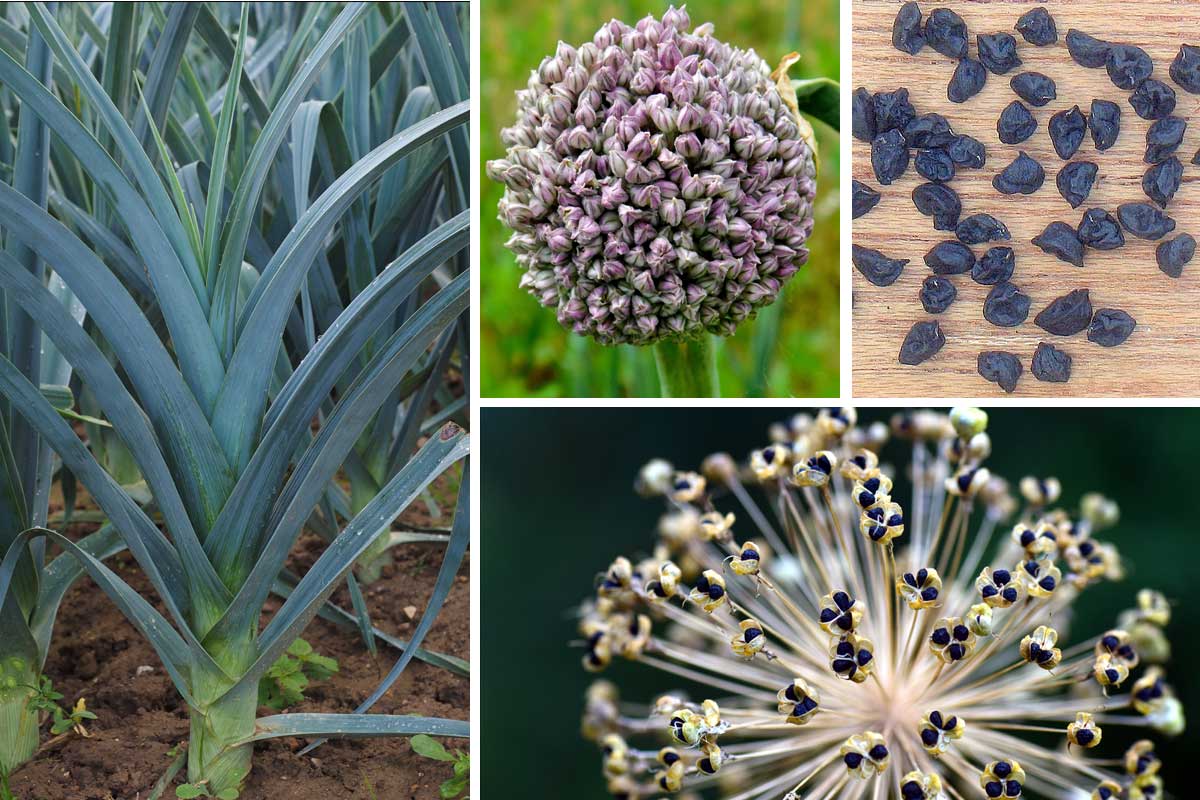
The leek in its entirety – Leek flowers – Leek seeds
Leek varieties
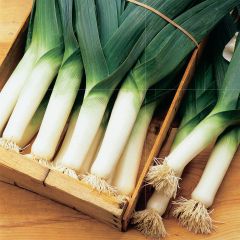
Electra Bio Leek - Ferme de Sainte Marthe seeds
- Height at maturity 40 cm
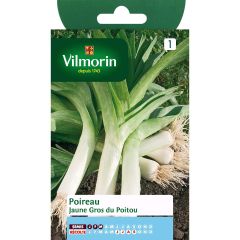
Yellow large from Poitou Leek - Vilmorin seeds - Allium porrum
- Height at maturity 65 cm
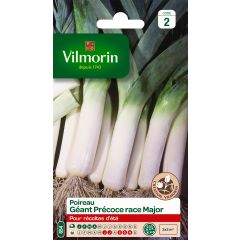
Leek Early Giant Major - Vilmorin Seeds
- Height at maturity 70 cm
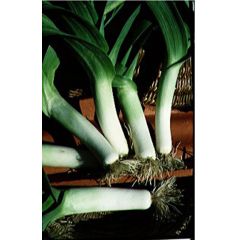
Malabar Leek - Allium porrum
- Height at maturity 40 cm
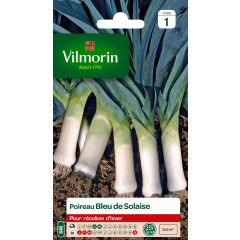
Leek Blue Solaise - Vilmorin Seeds
- Height at maturity 75 cm
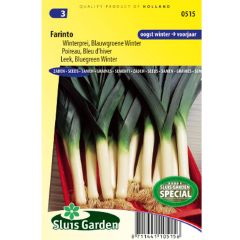
Leek Farinto
- Height at maturity 75 cm
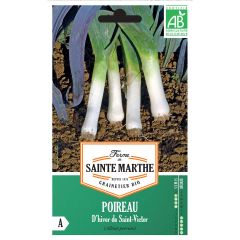
Leek De Saint Victor - Ferme de Sainte Marthe Seeds
- Height at maturity 45 cm
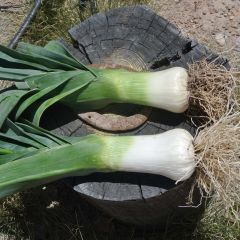
Monstrous Leek of Carentan Organic - Allium porrum
- Height at maturity 1 m
Discover other Leek seeds
View all →Available in 1 sizes
Available in 1 sizes
Available in 1 sizes
Available in 1 sizes
Available in 1 sizes
Available in 1 sizes
Available in 1 sizes
Available in 1 sizes
Available in 1 sizes
Available in 1 sizes
Sowing Leeks
Where and When to Sow Leeks?
Leeks can be sown throughout mainland France, even in mountainous climates as they are a vegetable that tolerates cold well.
Each leek variety has an ideal sowing period, which may vary in length: this information is provided on the seed packet, and it’s important to refer to it.
Generally, for a harvest:
- in summer, sow from mid-February to mid-May,
E.g.: ‘Gros long d’été’, ‘Jaune gros du Poitou’, ‘Géant précoce’ - in autumn, sow from mid-March to late April,
E.g.: ‘Monstrueux d’Elbeuf’, ‘Electra’, ‘de Carentan’ - in winter, sow from April to mid-May,
E.g.: Bleu de Solaise, ‘Vernor’, ‘de Saint-Victor’
How to Sow Leeks?
Leeks are ideally sown in an open-ground nursery but can also be sown in a fairly deep tray, such as a fish crate, at a minimum temperature of 13°C.
To sow, in practice:
- Dig a furrow 2 cm deep.
- Sow lightly, roughly one to two seeds per cm.
- Cover the furrow with garden soil or a special sowing compost if your soil is heavy.
- Gently firm the furrow with the back of a rake.
- Water gently using a watering can with a rose attachment
Germination will take between two weeks and three weeks, ensure you monitor moisture levels and water if necessary. You’ll then need to wait until the young plants reach about 15 cm tall and the thickness of a pencil, which will take 2 to 3 months after sowing. You can then proceed to transplanting.
Planting and transplanting leeks
When leeks sown in a nursery bed reach the right stage, that is, at least 15 cm tall and the thickness of a pencil, it’s time to plant them out.
To do this, carefully lift the young plants and let them dry or “recover” on the soil in the shade for a couple of days.
Be careful, it is extremely important to keep them in the shade, as full sun could dry them out and kill them. This step aims to remove the leek’s scent, thus reducing attacks by the leek moth.
Preparing and puddling leeks
Once the young plants have reached the diameter of a pencil, they should be prepared. For this step, trim the roots to 2-3 cm below the bulb and at the same time cut the young leaves a few cm above the bole. Removing the roots promotes better rooting by stimulating new root growth, and trimming the leaves prevents excessive evaporation.
After preparation, I recommend puddling, though this step is optional. Puddling involves coating the bare roots of the leek with a mud mixture made from equal parts garden soil and mature compost, then adding water. The leek roots are coated with this mud. The roots should be straight, heavy, and not curl during planting.
How to transplant leeks properly for beautiful white stems
Leeks prefer a sunny spot and rich, deep soil, heavily enriched with organic matter but without overly recent amendments. Loosen the bed and space rows 30 cm apart.
- On prepared soil, dig furrows at least 10 cm deep. To help with this, there is a specific tool called a ridging hoe, but if you don’t have one, you can use a wide hand hoe, a Dutch hoe, or even a draw hoe.
- Using a dibber (first photo below), make 10 cm deep holes, spaced 15 cm apart in the row.
- Plant your puddled young plants, ensuring the white part is fully buried.
- Water generously with the spout of the watering can, which will close the holes around the leek boles.
After watering, the leeks may appear flattened, but this is not a problem—they will straighten up within two weeks. Note that the furrow is not yet closed; this will happen gradually as you earth them up.
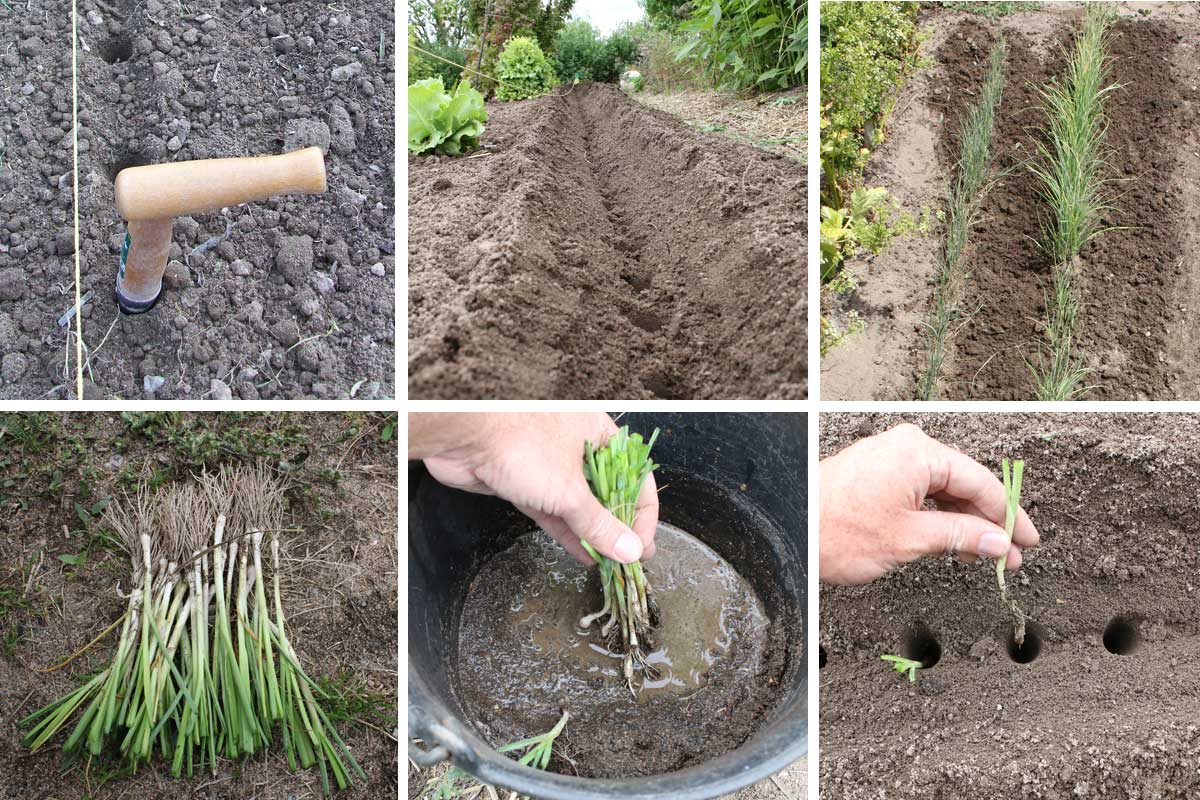
Planting leeks, step by step – Photographs: A. Gourmelen
Cultivation, Care and Companion Planting
To successfully grow leeks, it’s important to choose a good location and prepare the soil properly: Leeks should be planted in a sunny spot, in deep, rich soil. Adding compost or manure is necessary, at a rate of 3 to 4 kg per m2, preferably spread a few months before planting, as leeks dislike fresh or recent amendments.
About a month after planting, you should earth up the leeks to keep the bole shielded from light so it remains white and tender. Earthing up also helps increase the length of the white part. Soil from the sides of the furrow is drawn towards the centre to mound around the plants. Additional earthing up can be done to gradually extend the white portion of the leeks.
Regular maintenance involves hoeing and weeding, and watering should be consistent throughout summer, stopping when autumn moisture sets in.
In terms of companion planting, leeks pair very well with carrots. This is a beneficial partnership for both vegetables: the carrot fly dislikes the smell of leeks, and the leek moth isn’t fond of carrots! Tomatoes, lettuces and strawberries also make good companions for leeks, but leeks dislike being near their relatives, onions and other alliums (shallots, garlic), as well as beetroot and beans.
Regarding their association with strawberries, it’s the strawberries that particularly benefit from the presence of leeks, as they protect them from certain fungal diseases. You can plant a few leeks among your strawberry ranks. However, it must be said that growing leeks among strawberries is rather impractical in practice!
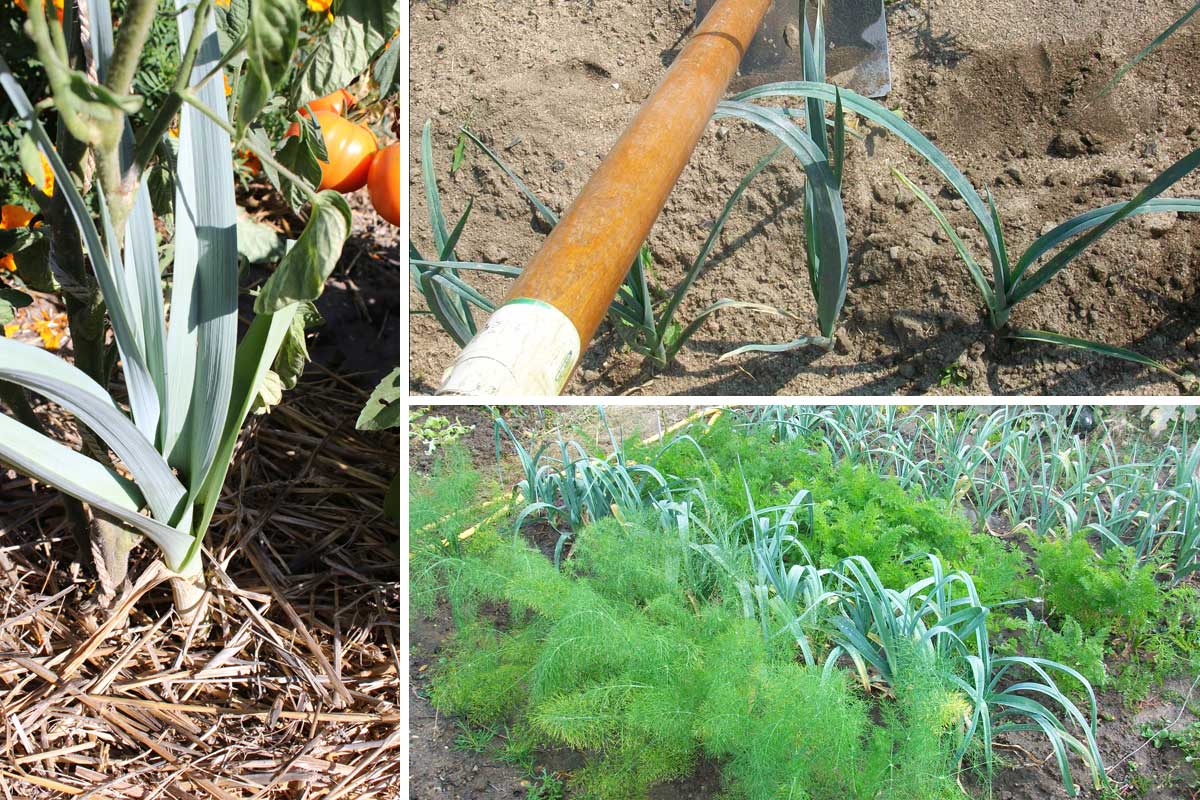
Leeks paired with tomatoes – Earthing up leeks, drawing soil to encourage white growth – Companion planting with fennel, leeks and carrots (fennel grows very well alongside leeks!)
Pests and Diseases of Leeks
Leek Moth and Leek Miner Fly
The leek moth (Acrolepiopsis assectella), a butterfly, along with the leek miner fly (Phytomyza gymnostoma) are the two main pests affecting leeks. The caterpillars or larvae burrow tunnels into the leaves before settling into the bole, significantly damaging the leeks. The miner fly causes damage in spring and autumn, while the leek moth appears from summer onwards.
Among all preventive measures, installing an insect-proof mesh is the most effective. However, it can be complemented or replaced (if you believe you’re not in a high-risk area) by:
- Companion planting with carrots, alternating ranks of carrots and ranks of leeks.
- Applying a mulch made from repellent plant waste (lavender, tansy).
- For further reading, check out Ingrid’s article on the subject: Leek Miner Fly: Protect Your Crops
Leek Rust
The most common disease affecting leeks is rust, caused by a fungus (Pucccinia porri), which appears in late summer as small orange spots on the foliage. This condition can be prevented by spraying horsetail decoction or Bordeaux mixture. Certain varieties, such as ‘Below Zero F1’ or ‘Oarsman F1’, are less susceptible to it.
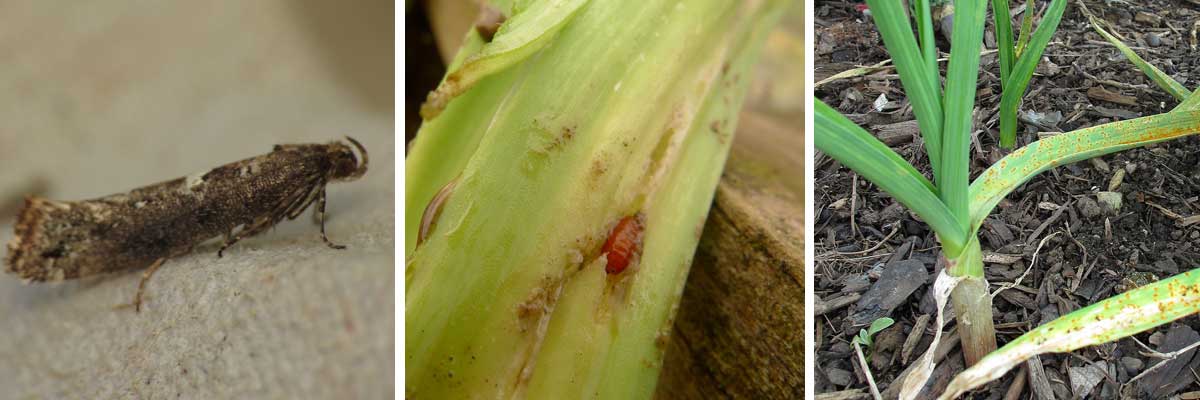
Adult leek moth – Leek miner fly at pupal stage – Leek rust
→ More details on leek diseases and parasitic pests in our advice sheet.
Harvest and store
The harvest usually takes place between 5 and 8 months after sowing and is carried out as needed.
To harvest, gently pull the leek to avoid damaging or injuring the bole. If you encounter difficulties during this operation, use a garden fork a few centimetres from the leek and lever it out more easily.
Winter leeks can be left in the ground and harvested as needed. Autumn leeks, which are not very frost-resistant, should be removed before the winter period.
At home, you can store leeks for two weeks in the vegetable drawer of your refrigerator. They can be kept for 3 months in the freezer. You should bag them after blanching them for a few minutes, rinsing them under cold water and then drying them thoroughly.
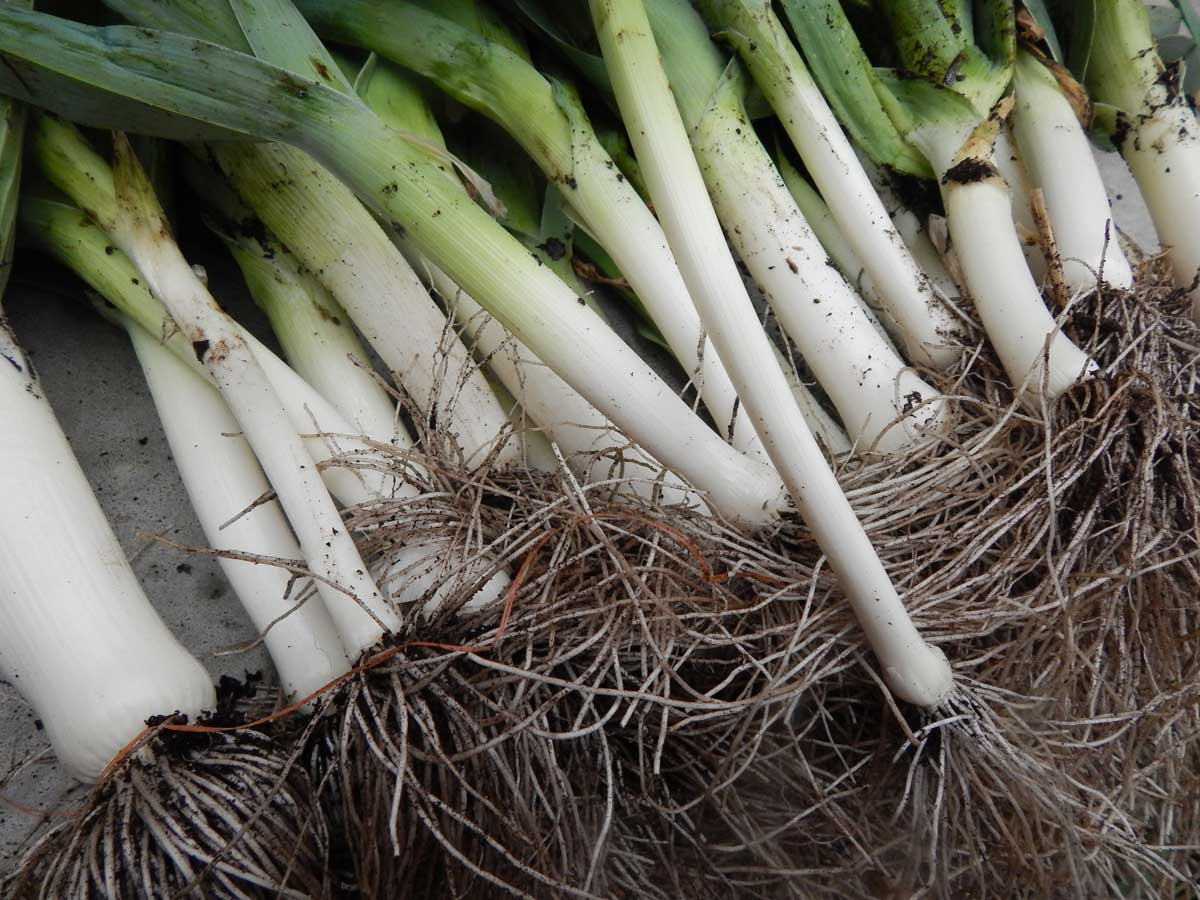
Uses and Nutritional Benefits
Leeks are rich in dietary fibre which aids digestion, as well as fructosans with diuretic properties. They are also abundant in vitamins C and B and contain sulphur compounds with antioxidant benefits. Like onions, leeks are reputed to help lower blood cholesterol levels, among other health advantages. The green part of leeks contains carotins and other antioxidant substances, which become even more concentrated during cold winter months.
Every part of the leek is edible—the green tops, white stems, and roots. It features in many regional dishes worldwide. A key ingredient in the traditional pot-au-feu, leeks are also enjoyed in soups, quiches, cold in vinaigrettes, or even raw, thinly sliced in salads. The Japanese are particularly fond of leeks, using them in numerous recipes such as sushi and sashimi, delicious sesame-glazed leeks, or miso soups.
It’s common for the green leaves and rootlets to be discarded. Instead of throwing them away, the leaves can be blended into soups or simply blanched and dipped in tempura batter to make fritters. The rootlets, once thoroughly cleaned, can be fried in a little oil for a crispy treat.
Useful resources
- Discover our wide range of leek seeds in our online shop.
- Advice sheet: growing summer leeks
- Find out about perennial leeks: planting and cultivation.
- Leek moth in the vegetable garden: prevention and natural treatments, all our advice!
Frequently asked questions
-
Why aren't my leeks growing bigger?
Several possibilities could explain why your leeks are too thin: they may have been sown too densely, causing the young plants to bolt rather than reaching the proper transplanting stage. In this case, it's difficult to correct their growth after transplanting. They may also lack fertiliser at planting time, or water, or they may have been transplanted too late in the year.
-
What to do with leek greens?
The green part of the leek, which is the richest in antioxidants, can be used in soups or simply blanched and dipped in a tempura batter to make fritters, for example.
-
Why do my leeks have worms?
If the worm looks like a caterpillar, it is the leek moth. Otherwise, if it has the appearance of a worm and is pale yellow, almost translucent, or is immobile and brown (at the pupal stage), it is the leek miner. See our advice above in the paragraph "Pests and diseases of leeks".
- Subscribe!
- Contents
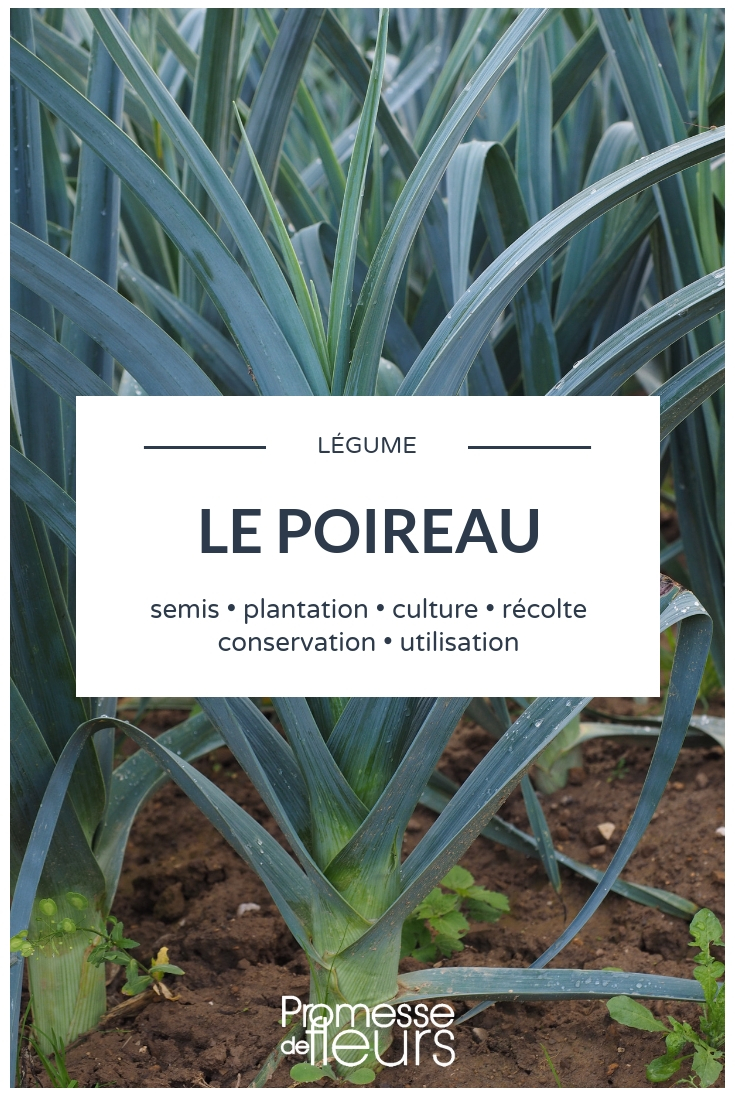


































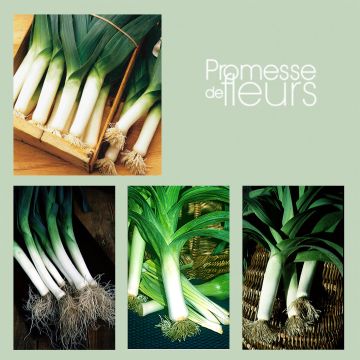
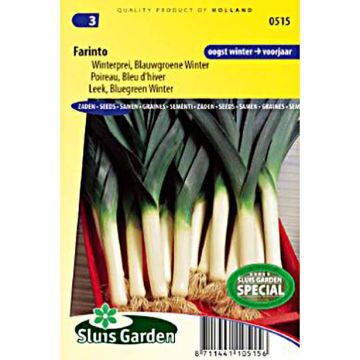
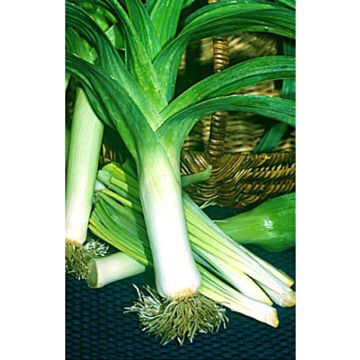
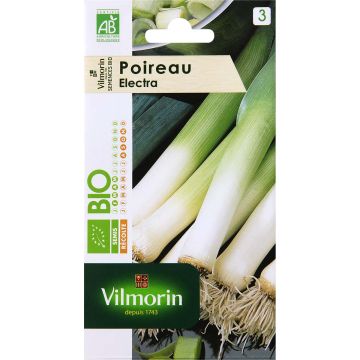
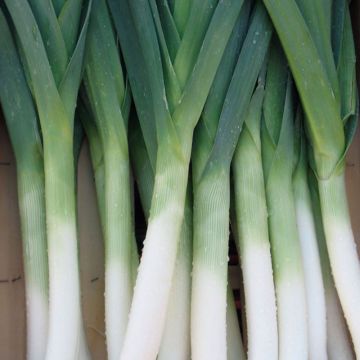
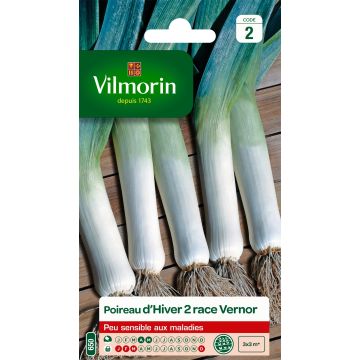
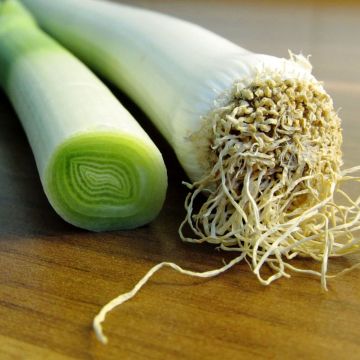
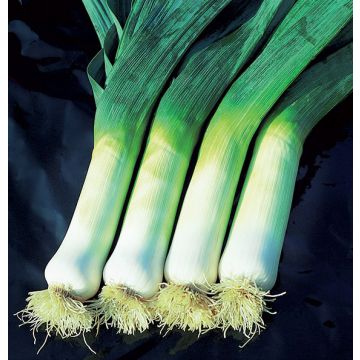
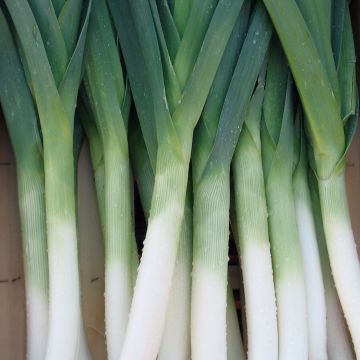
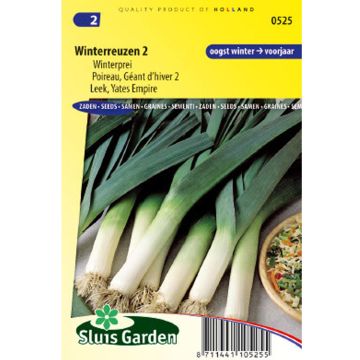
Comments